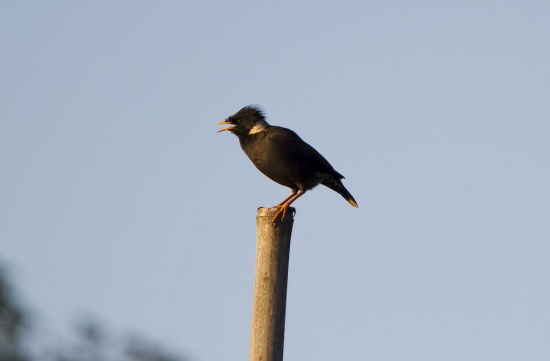(Picture added. References updated) |
(remove OBI link) |
||
| (One intermediate revision by the same user not shown) | |||
| Line 18: | Line 18: | ||
Uncommon to locally common. Poorly known. | Uncommon to locally common. Poorly known. | ||
==Taxonomy== | ==Taxonomy== | ||
| − | This is a [[Dictionary_M- | + | This is a [[Dictionary_M-O#M|monotypic]] species. |
| + | |||
==Habitat== | ==Habitat== | ||
Found in open grassland and moist areas like marshland. Also in cultivated areas and villages. Occurs from 800 - 1200m, in [[Burma]] up to 1525m. | Found in open grassland and moist areas like marshland. Also in cultivated areas and villages. Occurs from 800 - 1200m, in [[Burma]] up to 1525m. | ||
| Line 31: | Line 32: | ||
==External Links== | ==External Links== | ||
{{GSearch|Acridotheres+albocinctus}} | {{GSearch|Acridotheres+albocinctus}} | ||
| − | + | ||
[[Category:Birds]] [[Category:Acridotheres]] | [[Category:Birds]] [[Category:Acridotheres]] | ||
Latest revision as of 01:37, 30 April 2020
Alternative name: White-collared Myna
- Acridotheres albocinctus
Identification
25cm. A large, distinctive Myna.
- White neck collar
- Black head with short nasal crest
- Grey-black upperparts, slightly paler and duller underparts
- Black wing with small white wing patch
- Black undertail-coverts barred white
- Black tail with white tips
- Pale blue or azure blue-eye
- Orange-yellow bill
- Yellow legs
Sexes similar. Juveniles are browner than adults and have a pale throat.
Distribution
Found in extreme northeast India (Manipur), northern Burma and souther China (northwest Yunnan).
Uncommon to locally common. Poorly known.
Taxonomy
This is a monotypic species.
Habitat
Found in open grassland and moist areas like marshland. Also in cultivated areas and villages. Occurs from 800 - 1200m, in Burma up to 1525m.
Behaviour
Feeds on animal and plant food.
Forages mostly on the ground, often in flocks and often together with Great Myna. Often seen near cattle and buffalos.
Breeding season from April to June. A colonial breeder. The nest is placed in a tree hole or in a bank or hollow in a wall. Lays 4 eggs.
A resident species. Some local movements may occur.
References
- Clements, J. F., T. S. Schulenberg, M. J. Iliff, B.L. Sullivan, C. L. Wood, and D. Roberson. 2012. The eBird/Clements Checklist of Birds of the World. 6th ed., with updates to October 2012. Ithaca: Cornell Univ. Press. ISBN 978-0801445019. Spreadsheet available at http://www.birds.cornell.edu/clementschecklist/downloadable-clements-checklist
- Del Hoyo, J, A Elliott, and D Christie, eds. 2009. Handbook of the Birds of the World. Volume 14: Bush-shrikes to Old World Sparrows. Barcelona: Lynx Edicions. ISBN 978-8496553507
Recommended Citation
- BirdForum Opus contributors. (2025) Collared Myna. In: BirdForum, the forum for wild birds and birding. Retrieved 13 May 2025 from https://www.birdforum.net/opus/Collared_Myna




